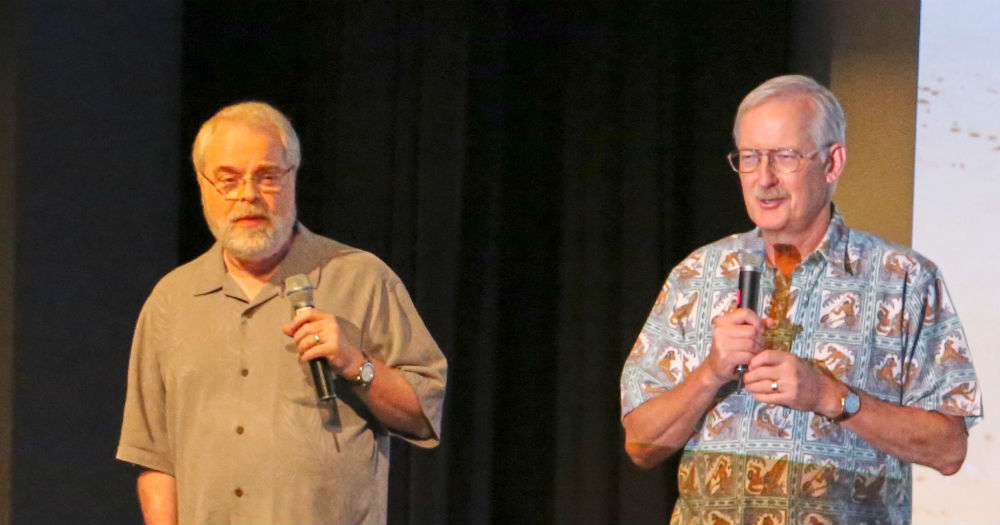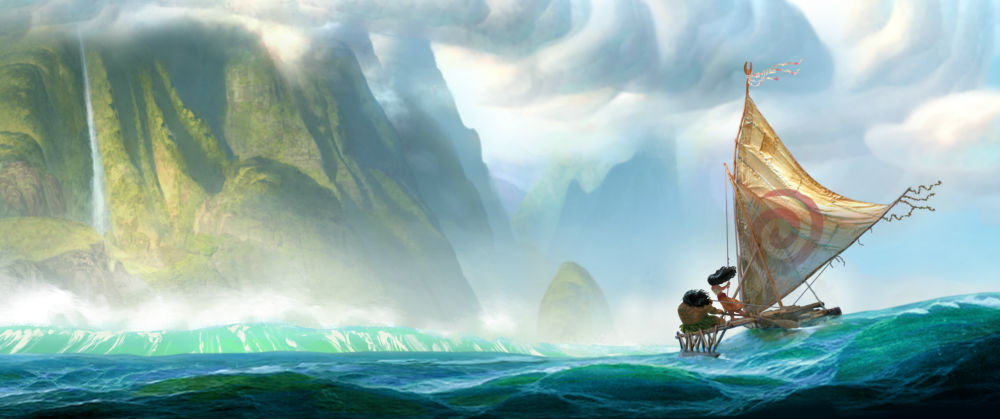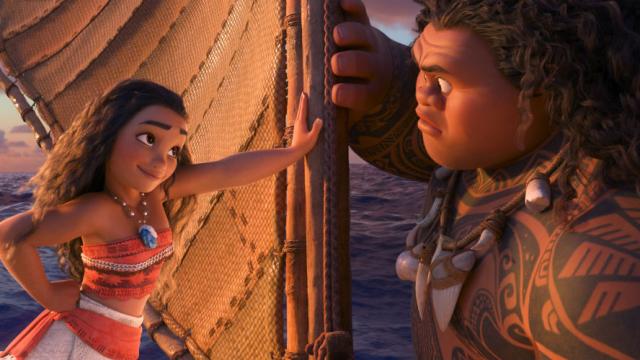With films like Frozen, Zootopia and Big Hero 6, Walt Disney Animation Studios is in the midst of a renaissance, much like it was in the early ’90s with films like Beauty and the Beast, The Little Mermaid and Aladdin. Now, with Disney’s latest film, Moana, these two eras are finally crossing over, thanks to directors Ron Clements and John Musker.
Moana schools Maui in Disney’s Moana. All Images: Disney
Clements and Musker may not be household names, but to Disney fans, who just call them Ron and John, they’re royalty. The pair directed not just Aladdin, The Little Mermaid and Hercules, but have been at the studio since the ’70s, working on other classics like The Rescuers, Pete’s Dragon and The Black Cauldron. Moana, however, is their first foray not just into computer animation, but a whole new mode of filmmaking shepherded by their old Cal Arts classmate and current boss, John Lasseter.
That mode of filmmaking is regularly referred to as “The Brain Trust” or “Story Trust”. Lasseter started it at Pixar, brought it to Disney Animation, and it’s since become kind of the gold standard in storytelling… as long as filmmakers and creators have the time. It’s a long, intricate process where a group of filmmakers dissect a colleague’s movie in every early form imaginable, over and over. Each time, changes are made, so that by the time actual production (or, in this case, animation) starts, the story is honed and as close to perfect as possible. It’s a sometimes brutally honest process that sees whole ideas get axed and characters completely change. But the result is always something better.
Why this is significant on Moana, though, is because it’s the first time the old school of Lasker and Clements worked in this new school aesthetic; Disney’s last golden age is finally embracing the new one.

Ron Clements (left) and John Musker (right) talking about Moana.
“[The Brain Trust] kind of grew out of [Lasseter’s], and our, Cal Arts experience where you just show people your stuff and get feedback,” Musker said. “And I would say back in those days, that vehicle was not there. I mean, [former Disney boss] Jeffrey Katzenberg definitely did it after a screening, and a few other people did, but there wasn’t a room of other directors who’d throw ideas at you.”
The pair admitted it was quite an adjustment, but, mostly, a fruitful one. “When you agree with people’s ideas it’s a good thing,” Musker said. “When you suggest something and they [say] ‘No, no, no, I don’t like that idea’ it seems less good.”
After going through the process, Musker and Clements think it takes filmmaking almost into a whole other genre. “In live-action, you write a script, then you film that script, and when you watch the movie there’s not much you can do,” Clements said.
“This is more like a theatrical model,” Musker added. “Where we take a play out of town. The play’s not going to open for a year or two, but you’re putting it up on the stage and you’re re-working it and that’s kind of what we do with these movies.”

In the case of Moana, not only the directors but head of story Dave Pimentel and writer Jared Bush admitted a lot was changed during the process.
“What we have now is the best version of what existed before,” Pimentel said. “It’s an easy thing to say, but, the truth is it kind of keeps the same spirit of what Ron and John intended to do. Even through all the iterations, all the reiterations of story trusts and up-and-down, 12 versions of the movie and all that stuff, it has now become the best example of what they wanted to do.”
For an example, the ending of the movie was changed less than a year before release. That was in part because the movie kept being honed to make sure Moana, and no one else, was the focus of the movie.
“We would always have to refocus the movie and say, ‘This is Moana’s story, not Maui’s story,’ Pimental said, referring to the second lead voiced by Dwayne Johnson. “To make sure we service that, and make sure that Moana is the one, at the end of the climax, who is saving the day. That was a huge, huge, factor that we really kept hammering on over the three-and-a-half years. Dwayne Johnson is so larger-than-life, he’s so great, but it’s Moana’s movie.”
Sometimes those changes meant adding – or losing – actual people. For example, Thor: Ragnarok director Taika Waititi wrote the first version of the film.
“He came in pretty early and we pitched him the story and he really liked it and was interested,” Clements explained. “It’s part of his whole heritage and he wrote several treatments and the first draft of script.”
However, because Waititi is a director himself, he simply couldn’t work on only one movie in five years. In fact, he’s made two in that time (What We Do in the Shadows and Hunt for the Wilderpeople) and just finished shooting his third (Thor: Ragnarok). That’s how long Moana has taken.

During that time, there was plenty of other personnel shifting around, too. “On this one, when we ran into story trouble, John Ripley came over, Jared [Bush] came on board and Chris Williams and Don Hall were [helping after] Big Hero 6 came out,” Musker said. “We were struggling with our story reels and trying to wrangle the story and get all this on the same wavelength.”
“It’s a very collaborative environment,” Clements added. “More so than it’s ever been. Everybody pitches in and everyone feels like we’re all working together on this stuff and we want it to be as good as it possibly can be.”
If Moana is as good as it possibly can be, the film could reach the heights of their early films. That’s what Bush and Pimentel hope, at least; each grew up singing Aladdin and Little Mermaid songs in their bedrooms, so working with Ron and John was a dream come true.
“These guys have so much energy,” Pimentell said. “They have so much life as if they just started their careers. On any given day, they will work harder than anyone else to get the best movie possible. And I’m completely inspired by their history and who they are now and what they’re going to do.”
As for Ron and John, they are no strangers to the ups and downs of Disney and just consider themselves fortunate to be back on the upswing.
“I started in January [in] 1974,” Clements said. “John was a couple years after me. It was really exciting to work at Disney, but there was a feeling like… there was this Golden Age of animation, where there was Snow White, Pinocchio, Fantasia – we weren’t really doing that. Things looked pretty dark and John Lasseter came in and turned things around.”
“The idea of Disney going through ups and downs is true to its own history, Clements added. “And we’ve been here long enough to see them.”
